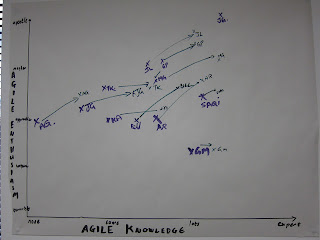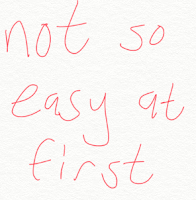Caveats:
Like all self-assessments, especially with scales, assessing your Wheel of Self reveals different results depending on when it is completed and how you're feeling and what you've been recently reflecting on.
Requirements:
Internet access
Quiet space
15 minutes to complete initial assessment
5 minutes to transfer to the second wheel
15-30 minutes to discuss
Step 1:
Give this link to the coachee: http://www.new-oceans.co.uk/new/wheel2.htm. Encourage the coachee to be as honest as possible, and not to think too much - go with their first instinct. The more honest they are, the more they will get out of this tool. Again I think the best time to complete this assessment is in the morning, before work really starts.
Step 2:
When the assessment is complete, you will have a "radar chart" / "spider graph" of various aspects of life that most people find important (Health & Well Being, Personal Growth, Achievements, Work-Career, Friendship, Security, Energy, Self-Esteem, Fun & Recreation, Home - Family, Relationship, Finance).
Discuss what the results mean to the coachee. Do they think or feel they should strive for more balance or are they comfortable? What do they think the outcome would be if they were willing to reallocate some of the time they spending on an outlier activity to lesser area? What prevents them from rebalancing? Would rebalancing take a long time? What are the rewards? And so on.
Step 3:
Another way to represent a 12-segmented Wheel is actually the Zodiac Wheel. Whether or not you believe in astrology, or your coachee does or does not, the Zodiac Wheel actually clearly shows opposite pairings (Career vs Home, Mental Explorations vs Communications, Death and Regeneration vs Possessions, Marriage and Partnership vs Self, Service and Health vs Self-Undoing, Creativity vs Hopes/Wishes and Friends). Thus usually it is clear if you overscore on say "Career" according to the Wheel on http://www.readingsbylafaye.com/12-Houses-of-the-Zodiac-Wheel.html you will underscore on "Home" and thus it is quick to create a prioritised plan to shift towards more balance ASAP.
Using both these wheels together (by transferring the scores from the 1st to the 2nd) make for a very interesting view for your coachee to look at themselves and understand themselves better. A lot of the people I work with for instance spend more time on Career activities or Home activities - a tiny minority actually feel they have balance between these two. And the same with Creativity or Friends - very few people commit to quiet times for themselves to engage in creative processes and thus recharge a different aspect of themselves for a more fulfilling life.
You now have more material, and perhaps a simple prioritisation mechanism, to help the coachee with setting up a coaching plan.
Like all self-assessments, especially with scales, assessing your Wheel of Self reveals different results depending on when it is completed and how you're feeling and what you've been recently reflecting on.
Requirements:
Internet access
Quiet space
15 minutes to complete initial assessment
5 minutes to transfer to the second wheel
15-30 minutes to discuss
Step 1:
Give this link to the coachee: http://www.new-oceans.co.uk/new/wheel2.htm. Encourage the coachee to be as honest as possible, and not to think too much - go with their first instinct. The more honest they are, the more they will get out of this tool. Again I think the best time to complete this assessment is in the morning, before work really starts.
Step 2:
When the assessment is complete, you will have a "radar chart" / "spider graph" of various aspects of life that most people find important (Health & Well Being, Personal Growth, Achievements, Work-Career, Friendship, Security, Energy, Self-Esteem, Fun & Recreation, Home - Family, Relationship, Finance).
Discuss what the results mean to the coachee. Do they think or feel they should strive for more balance or are they comfortable? What do they think the outcome would be if they were willing to reallocate some of the time they spending on an outlier activity to lesser area? What prevents them from rebalancing? Would rebalancing take a long time? What are the rewards? And so on.
Step 3:
Another way to represent a 12-segmented Wheel is actually the Zodiac Wheel. Whether or not you believe in astrology, or your coachee does or does not, the Zodiac Wheel actually clearly shows opposite pairings (Career vs Home, Mental Explorations vs Communications, Death and Regeneration vs Possessions, Marriage and Partnership vs Self, Service and Health vs Self-Undoing, Creativity vs Hopes/Wishes and Friends). Thus usually it is clear if you overscore on say "Career" according to the Wheel on http://www.readingsbylafaye.com/12-Houses-of-the-Zodiac-Wheel.html you will underscore on "Home" and thus it is quick to create a prioritised plan to shift towards more balance ASAP.
Using both these wheels together (by transferring the scores from the 1st to the 2nd) make for a very interesting view for your coachee to look at themselves and understand themselves better. A lot of the people I work with for instance spend more time on Career activities or Home activities - a tiny minority actually feel they have balance between these two. And the same with Creativity or Friends - very few people commit to quiet times for themselves to engage in creative processes and thus recharge a different aspect of themselves for a more fulfilling life.
You now have more material, and perhaps a simple prioritisation mechanism, to help the coachee with setting up a coaching plan.









![Merrill Covey Matrix (By Rorybowman (Own work) [Public domain], via Wikimedia Commons) Covey Matrix](https://upload.wikimedia.org/wikipedia/commons/3/32/MerrillCoveyMatrix.png)






